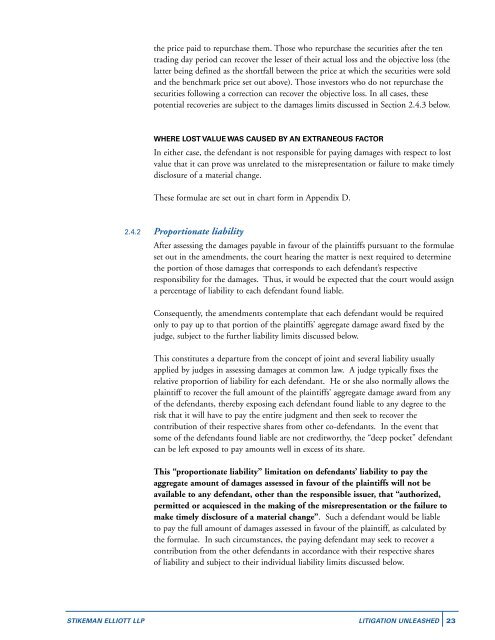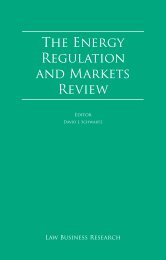LITIGATION UNLEASHED - Stikeman Elliott
LITIGATION UNLEASHED - Stikeman Elliott
LITIGATION UNLEASHED - Stikeman Elliott
You also want an ePaper? Increase the reach of your titles
YUMPU automatically turns print PDFs into web optimized ePapers that Google loves.
the price paid to repurchase them. Those who repurchase the securities after the ten<br />
trading day period can recover the lesser of their actual loss and the objective loss (the<br />
latter being defined as the shortfall between the price at which the securities were sold<br />
and the benchmark price set out above). Those investors who do not repurchase the<br />
securities following a correction can recover the objective loss. In all cases, these<br />
potential recoveries are subject to the damages limits discussed in Section 2.4.3 below.<br />
WHERE LOST VALUE WAS CAUSED BY AN EXTRANEOUS FACTOR<br />
In either case, the defendant is not responsible for paying damages with respect to lost<br />
value that it can prove was unrelated to the misrepresentation or failure to make timely<br />
disclosure of a material change.<br />
These formulae are set out in chart form in Appendix D.<br />
2.4.2 Proportionate liability<br />
After assessing the damages payable in favour of the plaintiffs pursuant to the formulae<br />
set out in the amendments, the court hearing the matter is next required to determine<br />
the portion of those damages that corresponds to each defendant’s respective<br />
responsibility for the damages. Thus, it would be expected that the court would assign<br />
a percentage of liability to each defendant found liable.<br />
Consequently, the amendments contemplate that each defendant would be required<br />
only to pay up to that portion of the plaintiffs’ aggregate damage award fixed by the<br />
judge, subject to the further liability limits discussed below.<br />
This constitutes a departure from the concept of joint and several liability usually<br />
applied by judges in assessing damages at common law. A judge typically fixes the<br />
relative proportion of liability for each defendant. He or she also normally allows the<br />
plaintiff to recover the full amount of the plaintiffs’ aggregate damage award from any<br />
of the defendants, thereby exposing each defendant found liable to any degree to the<br />
risk that it will have to pay the entire judgment and then seek to recover the<br />
contribution of their respective shares from other co-defendants. In the event that<br />
some of the defendants found liable are not creditworthy, the “deep pocket” defendant<br />
can be left exposed to pay amounts well in excess of its share.<br />
This “proportionate liability” limitation on defendants’ liability to pay the<br />
aggregate amount of damages assessed in favour of the plaintiffs will not be<br />
available to any defendant, other than the responsible issuer, that “authorized,<br />
permitted or acquiesced in the making of the misrepresentation or the failure to<br />
make timely disclosure of a material change”. Such a defendant would be liable<br />
to pay the full amount of damages assessed in favour of the plaintiff, as calculated by<br />
the formulae. In such circumstances, the paying defendant may seek to recover a<br />
contribution from the other defendants in accordance with their respective shares<br />
of liability and subject to their individual liability limits discussed below.<br />
STIKEMAN ELLIOTT LLP<br />
<strong>LITIGATION</strong> <strong>UNLEASHED</strong><br />
23
















